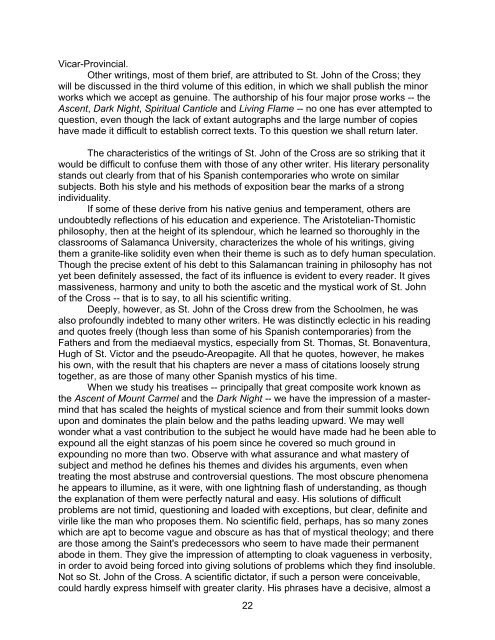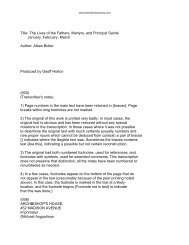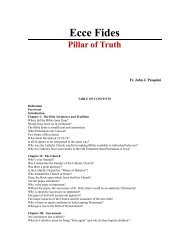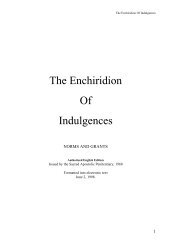Ascent of Mt. Carmel - St. Patrick's Basilica
Ascent of Mt. Carmel - St. Patrick's Basilica
Ascent of Mt. Carmel - St. Patrick's Basilica
You also want an ePaper? Increase the reach of your titles
YUMPU automatically turns print PDFs into web optimized ePapers that Google loves.
Vicar-Provincial.<br />
Other writings, most <strong>of</strong> them brief, are attributed to <strong>St</strong>. John <strong>of</strong> the Cross; they<br />
will be discussed in the third volume <strong>of</strong> this edition, in which we shall publish the minor<br />
works which we accept as genuine. The authorship <strong>of</strong> his four major prose works -- the<br />
<strong>Ascent</strong>, Dark Night, Spiritual Canticle and Living Flame -- no one has ever attempted to<br />
question, even though the lack <strong>of</strong> extant autographs and the large number <strong>of</strong> copies<br />
have made it difficult to establish correct texts. To this question we shall return later.<br />
The characteristics <strong>of</strong> the writings <strong>of</strong> <strong>St</strong>. John <strong>of</strong> the Cross are so striking that it<br />
would be difficult to confuse them with those <strong>of</strong> any other writer. His literary personality<br />
stands out clearly from that <strong>of</strong> his Spanish contemporaries who wrote on similar<br />
subjects. Both his style and his methods <strong>of</strong> exposition bear the marks <strong>of</strong> a strong<br />
individuality.<br />
If some <strong>of</strong> these derive from his native genius and temperament, others are<br />
undoubtedly reflections <strong>of</strong> his education and experience. The Aristotelian-Thomistic<br />
philosophy, then at the height <strong>of</strong> its splendour, which he learned so thoroughly in the<br />
classrooms <strong>of</strong> Salamanca University, characterizes the whole <strong>of</strong> his writings, giving<br />
them a granite-like solidity even when their theme is such as to defy human speculation.<br />
Though the precise extent <strong>of</strong> his debt to this Salamancan training in philosophy has not<br />
yet been definitely assessed, the fact <strong>of</strong> its influence is evident to every reader. It gives<br />
massiveness, harmony and unity to both the ascetic and the mystical work <strong>of</strong> <strong>St</strong>. John<br />
<strong>of</strong> the Cross -- that is to say, to all his scientific writing.<br />
Deeply, however, as <strong>St</strong>. John <strong>of</strong> the Cross drew from the Schoolmen, he was<br />
also pr<strong>of</strong>oundly indebted to many other writers. He was distinctly eclectic in his reading<br />
and quotes freely (though less than some <strong>of</strong> his Spanish contemporaries) from the<br />
Fathers and from the mediaeval mystics, especially from <strong>St</strong>. Thomas, <strong>St</strong>. Bonaventura,<br />
Hugh <strong>of</strong> <strong>St</strong>. Victor and the pseudo-Areopagite. All that he quotes, however, he makes<br />
his own, with the result that his chapters are never a mass <strong>of</strong> citations loosely strung<br />
together, as are those <strong>of</strong> many other Spanish mystics <strong>of</strong> his time.<br />
When we study his treatises -- principally that great composite work known as<br />
the <strong>Ascent</strong> <strong>of</strong> Mount <strong>Carmel</strong> and the Dark Night -- we have the impression <strong>of</strong> a mastermind<br />
that has scaled the heights <strong>of</strong> mystical science and from their summit looks down<br />
upon and dominates the plain below and the paths leading upward. We may well<br />
wonder what a vast contribution to the subject he would have made had he been able to<br />
expound all the eight stanzas <strong>of</strong> his poem since he covered so much ground in<br />
expounding no more than two. Observe with what assurance and what mastery <strong>of</strong><br />
subject and method he defines his themes and divides his arguments, even when<br />
treating the most abstruse and controversial questions. The most obscure phenomena<br />
he appears to illumine, as it were, with one lightning flash <strong>of</strong> understanding, as though<br />
the explanation <strong>of</strong> them were perfectly natural and easy. His solutions <strong>of</strong> difficult<br />
problems are not timid, questioning and loaded with exceptions, but clear, definite and<br />
virile like the man who proposes them. No scientific field, perhaps, has so many zones<br />
which are apt to become vague and obscure as has that <strong>of</strong> mystical theology; and there<br />
are those among the Saint's predecessors who seem to have made their permanent<br />
abode in them. They give the impression <strong>of</strong> attempting to cloak vagueness in verbosity,<br />
in order to avoid being forced into giving solutions <strong>of</strong> problems which they find insoluble.<br />
Not so <strong>St</strong>. John <strong>of</strong> the Cross. A scientific dictator, if such a person were conceivable,<br />
could hardly express himself with greater clarity. His phrases have a decisive, almost a<br />
22






